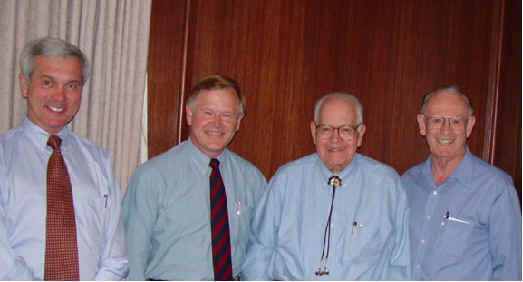George Furnival Honored
|
The many contributions of Dr. George M. Furnival to the field of statistics and forestry were praised at a recent luncheon held in his honor. George and his wife, Gloria, were both in attendance as twenty former students and colleagues reminisced and toasted George this past July 1st at the Grand Pacific Hotel in Victoria, B.C. A Picture from that event is featured in this issue of the Newsletter.
Tim Gregoire carried and read aloud a letter from the Dean of The Yale School of Forestry & Environmental Studies, who praised George not only for his nearly forty years of devoted service to the School but also for his monumental scientific contributions.
The Dean’s letter ended with a thought shared by all in the room: “On behalf of all that were there and all who have had the privilege and pleasure of knowing you, I speak with no trace of exaggeration in saying that it is indeed our great honor to have been in your company.”
Kim Iles presented George with an etching of a totem pole rendered by a British Columbian artist. Like the totem pole etching given to Lew Grosenbaugh at a similar gathering to honor him, this rendition featured totems illustrative of George’s career.
The inscription accompanying the gift read:
“The totem poles of the Pacific Northwest are meant to recognize and record the lives and contributions of individuals who were important to their tribe.
George Furnival, by anyone’s reckoning, commands a central position in our vocation, and this chief’s pole recognizes the position of George within the biometrics profession.
The collar on the eagle symbolizes the central role that Yale University has played in George’s life, and the contributions he has made to that university. Under the wings, marked “GMF” are some of the results of his scientific work, and the ideas and people that developed “under his wing”.
The computer cards of another era recall the early work he did with computers, his role in heading up the University Computer system, and his contribution to methods that computers would eventually incorporate into common practice.
The increment bore symbolizes his work in Growth and Yield, and the analytic methods he contributed to that specialty.
The “Tin Can” recalls his work in computer communications.
The academic robe on the eagle and the breastplate record some of the past, present and future in his academic life. George’s academic status, his MF, Doctorate, and the JP Weyerhaeuser chair are recorded on the robe.
The breastplate records the inheritor on his office, Tim Gregoire, George’s own professor Francis X. Schumacher, and the great influence of R.A.Fisher in that academic line.
The scale stick upon which the eagle stands is symbolic of the practical work of forest measurements to which George has contributed so much.
The fish symbolizes both the “leaps and bounds” method and the salmon he caught on a western river among friends and colleagues.
The graffiti at the pole bottom reminds us of days outside of Yale, and the importance of relationships and friends.”
In addition to Tim, other past students of George at Yale included Ian Cameron, Ann Camp, Ken Mitchell, Catherine Bealle Stradland, and Harry Valentine.
Many shared personal memories of their time with George, attesting not just to his prodigious acumen and intuition in matters of forest biometrics, but also his generosity and kindness that endeared him to them. Unable to attend, Ken Ware nevertheless emailed “Adventures with George” to share with the group, remembrances which dated back to 1957.
John Bell shared memories of sitting in class with George at Duke University as their mentor, F. X. Schumacher, explained the concepts of sampling. Long-time colleague on the faculty, Bill Reifsnyder, told tales of their many years together at Marsh Hall. Nearly everyone in attendance stood up at one point or another to recount a tale or two. George, too, joined in the fun by telling the history of how the roll-top desk in his former office was bequeathed to the School with the proviso that it never leave that office.
After three hours, the chairs were pushed back so that Kim could take group photographs, some of which are seen on these pages. It was a happy occasion that I am sure will be remembered fondly by all who shared in it.
Dr. Timothy G. Gregoire
J.P. Weyerhaeuser, Jr.
Professor, Yale
